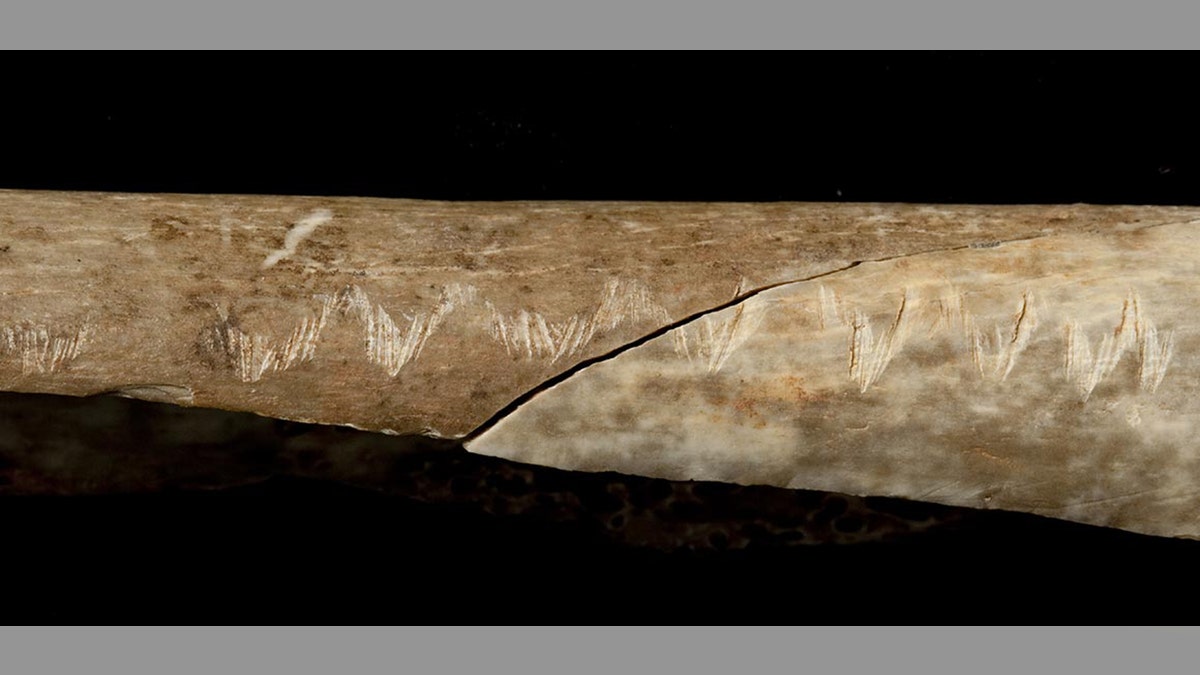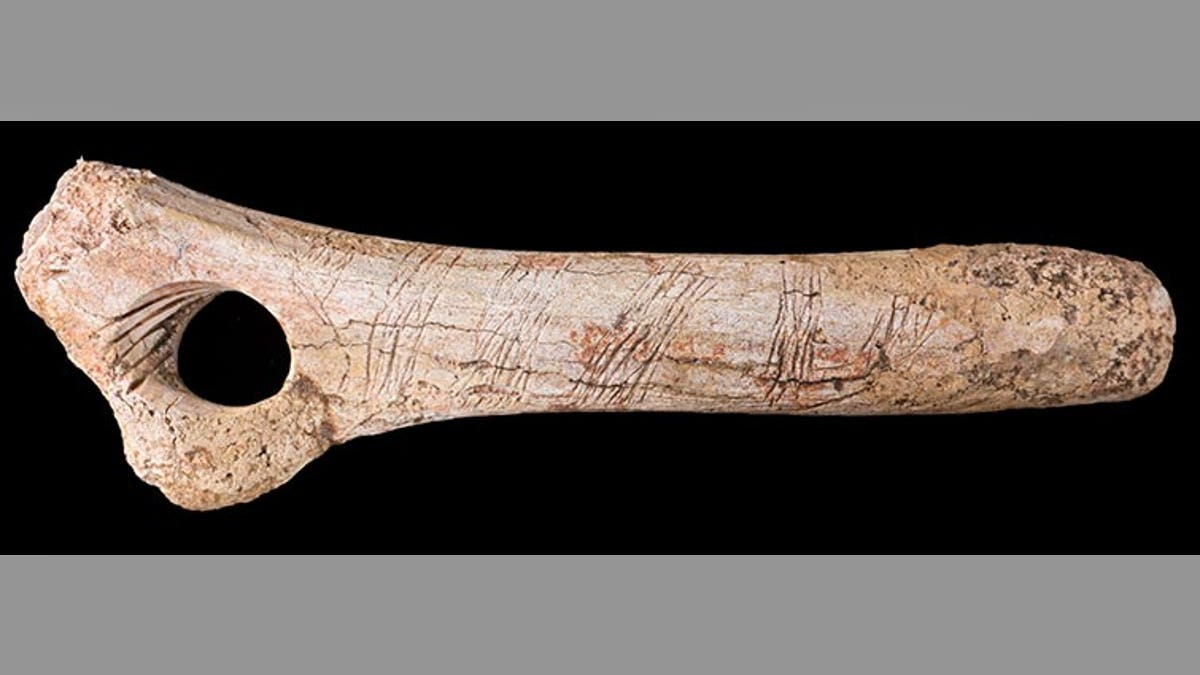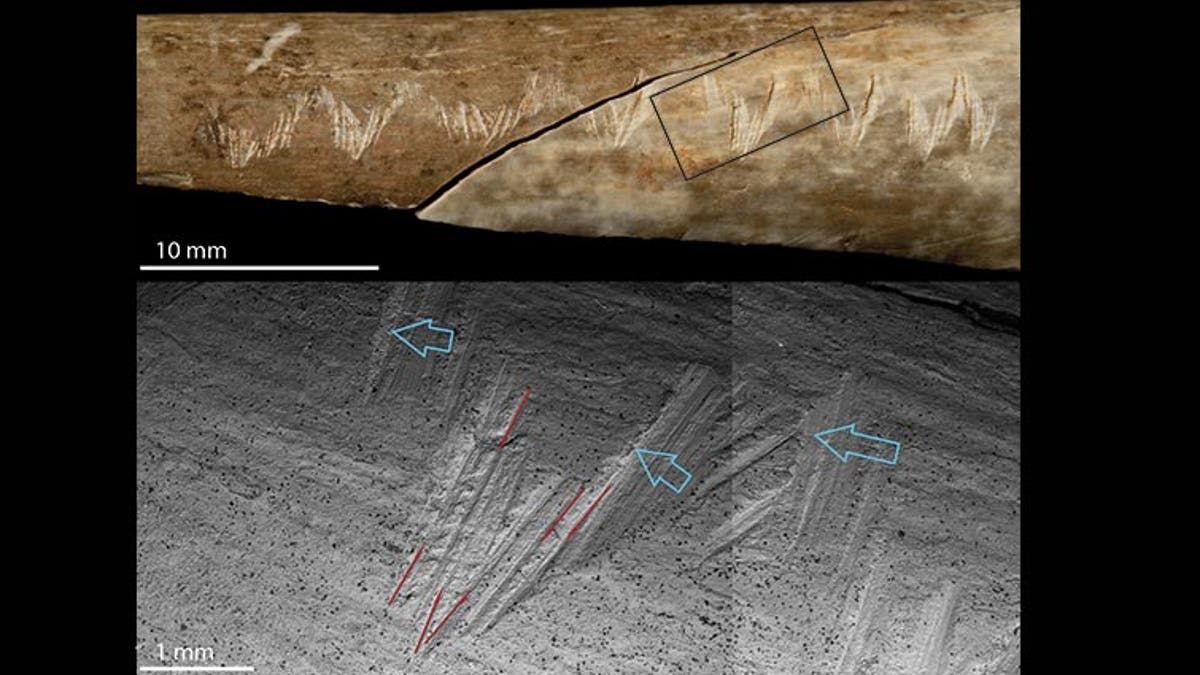
The engraved forearm bone discovered at Gough's Cave (Trustees of the Natural History Museum, London 2017)
A carved human bone from an archaeological dig in the U.K. is offering new insight into the grisly culture of prehistoric cannibals.
The forearm bone discovered at Gough’s Cave in Somerset, western England, had been filleted, then marked with bizarre zig-zag pattern before being broken open to extract the bone marrow, scientists say.
The bone was excavated in 1987 by a team led by paleontologists from the Natural History Museum in London. New analysis has revealed the artifact’s gruesome secrets.
TEMPLE OF DOOM: GRISLY 'SKULL CULT' DISCOVERY AT ANCIENT SITE
Experts describe the radius bone’s “cut marks, percussion damage and human tooth marks, indicative of cannibalism, as well as a set of unusual zig-zagging incisions,” in a paper published in the journal Plos One.

(Copyright © The Natural History Museum, London / Natural History Museum)
The human remains date from around 14,700 years ago, when the cave was occupied by the Ice Age Britons, according to the Natural History Museum in London. During their initial excavation of the site, researchers found human bones mixed with butchered animal remains and flint, bone and ivory artifacts.
“The sequence of modifications performed on this bone suggests that the engraving was a purposeful component of the cannibalistic practice, rich in symbolic connotations,” explained Dr. Silvia Bello, researcher in human origins at the Museum and lead author of the study, in a statement.
DNA DISCOVERY UNRAVELS THE MYSTERY OF EARLY GREEK CIVILIZATIONS
Earlier research carried out by the Museum has established that the cave’s inhabitants were cannibals. Scratches and marks on the human bones show that they were butchered in the same way and using the same tools as animal bones. Many of the human bones show human teeth marks, and have been broken open so that the marrow could be extracted, the Museum explained. Bone marrow is rich in protein and fat.

(© The Trustees of the Natural History Museum, London)
“However, there is no indication on the skeletons that the humans had suffered violence, so it is likely that they died of natural causes,” the Museum said, in its statement. “While the exact intent of the inhabitants' cannibalistic practices will never be certain, previous discoveries already suggested that it was not simply a matter of cannibalism for survival.”
Experts note that some of the skulls discovered in the cave show evidence of being carefully modified to produce skull-cups, rather than roughly stripped of their flesh. “The craniums were removed from the rest of the skull and rough edges chipped off to produce bowl-like objects, showing that the living inhabitants were not just treating the deceased as food,” explained the Museum.
TEENAGER’S DISCOVERY OF ROMAN TREASURE TROVE DELIGHTS EXPERTS
Researchers used a microscope to study the marks on the forearm bone made by stone tools. By employing three-dimensional analysis they were able to work out which marks were the results of butchery and which were the results of engraving.

The engravings were likely made in one sitting by a single individual, using one tool.
“The sequence of the manipulations strongly suggests that the engraving was an intrinsic part of the multi-stage cannibalistic ritual and, as such, the marks must have held a symbolic connotation,” said Dr. Bello. “Archaeologists have linked the engraving of objects and tools to ways of remembering events, places or circumstances, a sort of ‘written memory’ and ‘symbolic glue’ that held together complex social groups.”
'ALESI,' THE 13-MILLION-YEAR-OLD BABY MONKEY, COULD BE MANKIND’S EARLIEST ANCESTOR
The zig-zag patterns indicate that they may have been made by the Magdalenians, a prehistoric culture that lived across Western Europe. The Gough’s Cave artifact is the earliest examples of an engraved human bone, according to the archaeologists.
This is the latest grisly archaeological revelation. Archaeologists in Turkey, for example, recently revealed that human skulls may have once decorated an ancient temple at Göbekli Tepe.




















